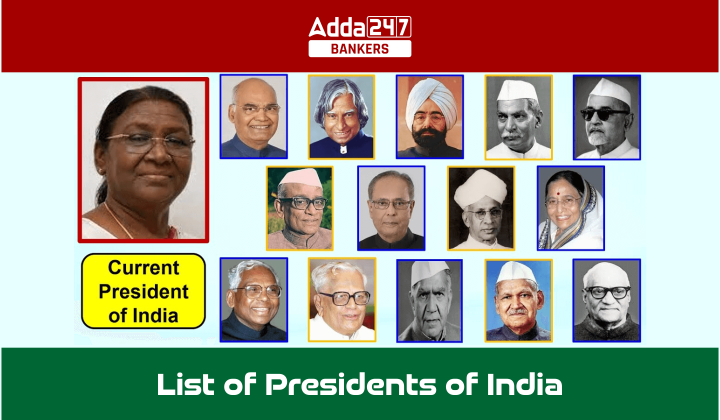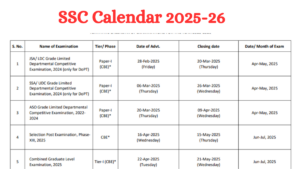Table of Contents
President is known as the Head of the State and also the Head of the Government. In 1947, India gained its independence from years of struggles with British rule. This year became the historic year for India as we were free from any ruler. The Constitution of India was amended on January 26, 1950, and Dr. Rajendra Prasad was elected as the first constitutional head of the state commonly named as the President of India. Draupadi Murmu is the present President Of India, who started her tenure on 25 July 2022.
Presidents of India From 1950 to 2025
General Awareness is one section that you will find in almost every government sector exam. Be it banking exams or SSC, you will find in this section all of these exams. Those exams where interviews are conducted, GA becomes even more important because in an interview they ask you very basic questions just to check your general awareness rather than your knowledge. So make sure you prepare this section nicely in order to ace the main examination as well as the interview because the final merit list is prepared based on these two stages.
President of India
The President is the constitutional head of the complete parliamentary system of the government of India. It is important to note that India’s President represents the nation and does not rule the country, the actual power lies in the hands of the council of ministers of India.
Name of Presidents of India From 1950 to 2025
President is the highest ranking official also known as the first citizen who represent the country on the international stages. The role of a President is very crucial as they frame the policies, sign legislation into law, etc. From the examination perspective, List of Presidents of India is an important topic from which question arises in the General Awareness section. The given table comprises complete List of Presidents of India From 1950 to 2025.
| Presidents Of India List |
|||
| Name | Starting date | Closing date | Profiles |
| Dr. Rajendra Prasad | January 26th, 1950 | May 13th, 1962 | He was the first President of the republic India. |
| Dr Sarvepalli Radhakrishnan | May 13th, 1962 | May 13th, 1967 | He was the 2nd President of India. |
| Dr Zakir Hussain | May 13th, 1967 | May 3rd, 1969 | He was the 3rd President of India. |
| Varahagiri Venkata Giri | May 3rd, 1969 | July 20th, 1969 | He was acting President because of Hussain’s death. |
| Mohammad Hidayatullah | July 20th, 1969 | August 24th, 1969 | He was acting President till Giri’s presidency. |
| Varahagiri Venkata Giri | 24th August 1969 | 24th August 1974 | He was the 4th President of India. |
| Fakhruddin Ali Ahmed | 24th August 1974 | 11th February 1977 | He was the 5th President of India. |
| Basappa Danappa Jatti | 11th February 1977 | 25th July 1977 | He was a chief minister of the Mysore but got elected as President, After the death of Fakhruddin Ali Ahmed. |
| Neelam Sanjiva Reddy | 25th July 1977 | 25th July 1982 | Reddy was the 6th President of India unopposed. |
| Giani Zail Singh | 25th July 1982 | 25th July 1987 | He was the 7th President of India and was also a member of the Congress party. |
| Ramaswamy Venkataraman | 25th July 1987 | 25th July 1992 | He was the 8th President of India. He was also a lawyer and a professional politician. |
| Shankar Dayal Sharma | 25th July 1992 | 25th July 1997 | He was the 9th President of India, and he was also a member of the National Congress party of India. |
| Kocheril Raman Narayanan | 25th July 1997 | 25th July 2002 | He was the 10th President of India and the best diplomat in India. |
| Dr. A.P.J. Abdul Kalam | 25th July 2002 | 25th July 2007 | He was the 11th President of India, and he was a great scientist. He worked in ISRO and DRDO organizations. |
| Pratibha Patil | 25th July 2007 | 25th July 2012 | She was the 12th President of India, and she was the first woman to Be President. |
| Pranab Mukherjee | 25th July 2012 | 25th July 2017 | He was the 13th President of India, and he was also a senior leader of the National Congress party. |
| Shri Ram Nath Kovind | 25th July 2017 | 25th July 2022 | He is the 14th President of India, and he is also the ex-governor Of Bihar. |
| Draupadi Murmu | 25th July 2022 | Working | She is the 15th President of India and 2nd female president of India after Pratibha Patil. |
List of All Presidents of India From 1950 to 2025
Draupadi Murmu (2022-2027)
Draupadi Murmu has become the 15th President of India. She has become the first tribal and second woman to become president of India. Drupadi is a tribal leader from Odisha. Draupadi Murmu who was nominated by BJP as the National Democratic Alliance’s candidate won the Presidential election beating opposition candidate Yashwant Sinha.
Shri Ram Nath Kovind (2017-2022)
Ram Nath Kovind is a Dalit leader and he was born in Paraukh village in the Kanpur Dehat district. Ram Nath Kovind is the 14th and currently serving the nation as President. He was the 36th Governor of Bihar and was also a member of Parliament and Rajya Sabha. He had also represented India in United Nations in New York and in October 2002. He also served as a member of the Board of Management of the Dr. B.R Ambedkar University, Lucknow, and a Member of the Board of Governors of the Indian Institute of Management, Kolkata.
Pranab Mukherjee (2012-2017)
Dr. Pranab Mukherjee was elected as the 13th President of India in 2012. Before elected as president, Pranab Mukherjee was the Union Finance Minister in 2009. In his political career, he was a well-known face of the Congress party as a top troubleshooter. He was elected five times for the Rajya Sabha from 1969 and twice to Lok Sabha from 2004. He was an active member of the Congress Working Committee for a long duration of almost 23 years. Rashtriya Samajwadi Congress was his own party which later on was merged with Congress in 1989 after a mutual discussion with Rajiv Gandhi.
Pratibha Patil (2007-2012)
Smt. Pratibha Devi Singh Patil was 12th President of India and was the first woman President. She was born in Nadgaon village of Jalgaon district of Maharashtra. At her age of 27, she was elected to the Maharashtra Legislative Assembly for the Jalgaon constituency. Smt. Pratibha Patil was elected as the Governor of Rajasthan for the duration of 2004-2007. She was also elected as a Member of Parliament representing the Amravati constituency in the 10th Lok Sabha elections.
Dr. A.P.J Abdul Kalam (2002-2007)
Abul Pakir Jainulabdeen Abdul Kalam who was well known with the name A P J Abdul Kalam was the 11th President of India. He received the famous name of the Missile Man of India as he was involved in the development of ballistic missile and launch vehicle technology in the nation as he was a scientist and science administrator at DRDO and ISRO. He was also awarded Bharat Ratna and was an inspiration to the young generation for achieving foster education and values.
Kocheril Raman Narayanan (1997-2002)
Before elected as president, he was an ambassador to Japan, the United Kingdom, Thailand, Turkey, the People’s Republic of China, and the United States of America. He was referred to as “the best diplomat of India” by Jawaharlal Nehru. Upon the request of Indira Gandhi, he entered into politics and won three continuous times in general elections to the Lok Sabha. He also served the nation as a Minister of State in the Union Cabinet under the period of former Prime Minister Rajiv Gandhi. In 1992, he was elected as the ninth Vice President and in 1997, he became the 10th President of India. He was the first president who belongs to the Dalit community to hold the post of President.
Shankar Dayal Sharma (1992-1997)
During the period of R. Venkataraman, Shankar Dayal Sharma served as the vice president of India, and in 1992, he was elected as 9th President of India. He served as Chief Minister of Bhopal, Cabinet Minister of India. He was involved in the struggle of Indian independence during the 1940s and joined the Indian National Congress party later on. He worked on the portfolios of Education, Industry, and Commerce, Law, Public Works, National Resources, and Separate Revenue during his political career.
Ramaswamy Venkataraman (1987-1992)
Shri Venkataraman served as a Union minister of India and was elected as the eighth President of India. He participated in the Quit India Movement and was an activist. Previously he was a freedom fighter and later he joined the Congress party and was elected four times in the Lok Sabha and as a member of Constitutional Assembly. Before President, he served as the Finance Minister and Defence Minister, and Vice President.
Giani Zail Singh (1982-1987)
Giani Zail Singh served as the seventh President of India. He holds several ministerial posts in the Union Cabinet and belonged to the Indian National Congress party. Giani Zail Singh was elected in the times which was the most controversial period marked by Operation Blue Star. In 1972, he was selected as a Congress Chief Minister of Punjab in 1972.
Neelam Sanjiva Reddy (1977-1982)
Shri Neelam Sanjiva Reddy sixth President of India for the time period of 1977 to 1982 after he joined the Janata Party and later on he joined the Indian National Congress. Mr. Reddy before elected as President was the Union Minister under the leadership of Prime Ministers Lal Bahadur Shastri and Indira Gandhi and served as the Chief Minister of Andhra Pradesh state. He was the Minister for Prohibition, Housing, and Forests of the Madras State for two years from 1949-1951.
Fakhruddin Ali Ahmed (1974-1977)
Dr. Fakhruddin Ali Ahmed was the fifth elected President of India in 1974. He was the 2nd President of India who died in the office. He issued the proclamation of emergency across the country by signing the papers at midnight after a meeting with Indira Gandhi and became the most controversial term. He was also arrested in the Quit India movement in 1942 and was sent to three and a half years’ of imprisonment.
V Giri (1969-1974)
Varahagiri Venkata Giri was elected as an independent candidate after the sudden death of Zakir Hussain and became the fourth president of India. He served as India’s first High Commissioner to Ceylon for the duration of 1947-1951. He was elected to the 1st Lok Sabha from Pathapatnam Lok Sabha Constituency in the Madras State in 1951. He had also been the Governor of various states like Uttar Pradesh, Kerala, and Karnataka before he served the nation as the Vice President and President.
Zakir Husain (1967-1969)
Zakir Hussain was the first Muslim to be elected as the third President of India. He died on 3rd May 1969 and has the shortest period as the President due to his death in his serving period. He also holds the post of the Vice-Chancellor of the Aligarh Muslim University and was the co-founder of the Jamia Millia Islamia University of Delhi. He previously served as Governor of Bihar and as Vice President of India before he became President. He received the Bharat Ratna in 1963 for his good deeds.
Sarvepalli Radhakrishnan (1962-1967)
He was elected as the 2nd president of India after Independence and served the nation for the duration of 1962-1967. Radhakrishnan was an Indian philosopher and statesman, who was the first Vice President of India from 1952 to 1962 before his election for President. He received various awards during his career, including a knighthood award, Bharat Ratna, the highest civilian award, and honorary membership of the British Royal. Radhakrishnan represented India at UNESCO after the independence of India and later on, was elected as the Ambassador of India to the Soviet Union in 1949.
Rajendra Prasad (1950-1962)
Rajendra Prasad was the first president of the Republic of India and represented the nation for the time period of 1950-1962. He was also a companion of Mahatma Gandhi in the noncooperation movement for the fight of independence. Rajendra Prasad was a politician, lawyer, journalist, and was president of the Indian National Congress party. He wrote many famous books, a few of them are Atmakatha, India Divided, Mahatma Gandhi and Bihar, Some Reminiscences, and many others. His lifespan was from 03 December 1884 to 28 February 1963. 
Eligibility Criteria for President of India
The Indian constitution includes article 58 which claims the complete description of eligibility rules for the President of India. Some of the following have given below:
- The President should be a citizen of India.
- The President must be above the age of 35 years.
- The President should be a member of the Lok Sabha and should get qualified for standing in the elections.
- The President of India should not contain any office of profit under the State Government, Union, and other local authorities.
Position of the President of India
President holds the position of highest honour, dignity, and prestige in the nation, as the head of the state with all executive power of the Union vested in him and all executive actions of the Government of India are taken under his name.
- President is the supreme commander of the Armed Forces, with all authority to declare war and peace in India.
- Bills after passed by the Parliament must receive the assent of the President of India to become laws in the nation.
- The President of India also has the power to grant pardons, reprives, respites, or remissions of punishment or to suspend, remit or commute the sentence of any person in all cases where the punishment has been awarded by a court, for an offense against a Union Law or is a sentence of death.
- President can also proclaim a state of Emergency in the whole or a part of India and article 360 of the constitution gives the President the right to declare a financial emergency in the country.
Election and Tenure of the President of India
The Presidential election provisions are laid down in Article 54 of the Constitution of India. The President of India is elected indirectly by an Electoral College following the system of proportional representation utilizing a single transferable vote system and secret ballots. MPs and MLAs vote based on parity and uniformity values.
The President is elected for a tenure of 5 years but is eligible for immediate re-election and can serve any number of terms.



 GA Capsule for SBI Clerk Mains 2025, Dow...
GA Capsule for SBI Clerk Mains 2025, Dow...
 The Hindu Review October 2022: Download ...
The Hindu Review October 2022: Download ...
 SSC Calendar 2025 Under Review, Dates So...
SSC Calendar 2025 Under Review, Dates So...


